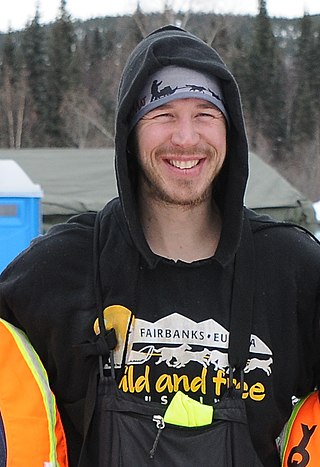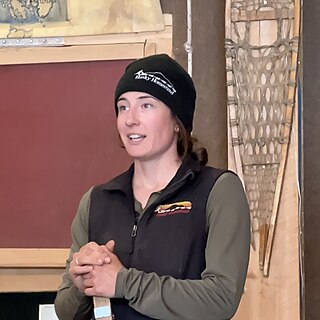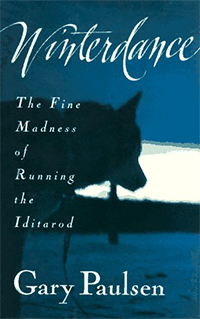
The Iditarod Trail Sled Dog Race, more commonly known as The Iditarod, is an annual long-distance sled dog race held in Alaska in early March. It travels from Anchorage to Nome. Mushers and a team of between 12 and 16 dogs, of which at least 5 must be on the towline at the finish line, cover the distance in 8–15 days or more. The Iditarod began in 1973 as an event to test the best sled dog mushers and teams but evolved into today's highly competitive race.

A sled dog is a dog trained and used to pull a land vehicle in harness, most commonly a sled over snow.

The Iditarod Trail, also known historically as the Seward-to-Nome Trail, is a thousand-plus mile (1,600 km) historic and contemporary trail system in the US state of Alaska. The trail began as a composite of trails established by Alaskan native peoples. Its route crossed several mountain ranges and valleys and passed through numerous historical settlements en route from Seward to Nome. The discovery of gold around Nome brought thousands of people over this route beginning in 1908. Roadhouses for people and dog barns sprang up every 20 or so miles. By 1918 World War I and the lack of 'gold fever' resulted in far less travel. The trail might have been forgotten except for the 1925 diphtheria outbreak in Nome. In one of the final great feats of dog sleds, twenty drivers and teams carried the life-saving serum 674 miles (1,085 km) in 127 hours. Today, the Iditarod Trail Sled Dog Race serves to commemorate the part the trail and its dog sleds played in the development of Alaska, and the route and a series of connecting trails have been designated Iditarod National Historic Trail.

The Yukon Quest, formally the Yukon Quest 1,000-mile International Sled Dog Race, is a sled dog race scheduled every February since 1984 between Fairbanks, Alaska, and Whitehorse, Yukon, switching directions each year. Because of the harsh winter conditions, difficult trail, and the limited support that competitors are allowed, it is considered the "most difficult sled dog race in the world", or even the "toughest race in the world"—"even tougher, more selective and less attention-seeking than the Iditarod Trail Sled Dog Race." The originator envisioned it as "a race so rugged that only purists would participate."

Jeff King is an American musher and sled dog racer. He is generally credited with introducing the sit-down sled which has largely replaced the standing sled traditionally used by distance mushers.

Togo was the lead sled dog of musher Leonhard Seppala and his dog sled team in the 1925 serum run to Nome across central and northern Alaska. Despite covering a far greater distance than any other lead dogs on the run, over some of the most dangerous parts of the trail, his role was left out of contemporary news of the event at the time, in favor of the lead dog for the last leg of the relay, Balto, whom Seppala also owned and had bred.
Joe Redington, Senior was an American dog musher and kennel owner, who is best known as the "Father of the Iditarod Trail Sled Dog Race", a long distance sled dog race run annually from the Anchorage area to Nome, Alaska.
Dorothy G. Page was best known as "Mother of the Iditarod Trail Sled Dog Race", the 1,049-mile dog sled race across the U.S. state of Alaska.
The Junior Iditarod Sled Dog Race, or Jr. Iditarod, is a 148- to 158-mile sled dog race for mushers between the ages of 14 through 17, which is patterned after the 1,150-mile Iditarod Trail Sled Dog Race that is said to be 1,049 miles (1,688.2 km). The race is held outside Anchorage in the U.S. state of Alaska, and was the first long-distance race for juvenile mushers.

DeeDee Ann Jonrowe is an American kennel owner and dog musher who is a three-time runner up in the Iditarod Trail Sled Dog Race. She is a very popular figure in the sport, and her completion of the 1,049-mile+ race in 2003 just three weeks after completing chemotherapy for breast cancer received widespread publicity.
The ceremonial start of the 34th annual (XXXIV) Iditarod Trail Sled Dog Race across the U.S. state of Alaska began amidst the crowds of Anchorage on March 4, 2006, and the start of the competitive race, or "restart", began the next day in Willow. The race followed a modified version of the northern route for 1,151 mi (1,852 km) across the Alaska Range, through the sparsely inhabited Interior, along the Yukon River, and then up the coast of the Bering Sea to the city of Nome. Unlike in previous years, where the teams had to deal with unseasonably warm temperatures and soft, mushy snow, the weather was cold, with temperatures reported as low as −40 °F (−40 °C).

Ramy "Ray" Brooks is an Alaska Native kennel owner and operator, motivational speaker, and dog musher who specializes in long-distance races. He is a two-time runner up in the 1,049+ mi Iditarod Trail Sled Dog Race across the U.S. state of Alaska, and a former winner of the 1,000 mi (1,600 km) Yukon Quest dog sled race across both Canada and the U.S.

John Quniaq Baker is a self-employed American dog musher, pilot and motivational speaker of Inupiat descent who once consistently placed in the top 10 during the long distance Iditarod Trail Sled Dog Race. Baker won the 2011 Iditarod with a finish time of 8 Days 19 Hours 46 Minutes 39 Seconds.

Woodsong is a book of memoirs by Gary Paulsen. The first half consists of Paulsen's early experiences running sled dogs in Minnesota and then in Alaska, and the second half describes the roads and animals he faces in the Iditarod Trail Sled Dog Race.

Lance Mackey was an American dog musher and dog sled racer from Fairbanks, Alaska. Mackey was a four-time winner of both the 1,000-mile (1,600 km) Yukon Quest and the Iditarod Trail Sled Dog Race.
The Tustumena 200 Sled Dog Race is a dog sled race on the Kenai Peninsula of Alaska covering 200 miles. Established in 1983, the race is run each year on the last weekend in January, and has grown in reputation to draw competitive distance mushers from Alaska, the lower 48, and international locations. The Tustumena 200 boasts one of the highest purses for a dog sled race in its class. The minimum guaranteed purse is $25,000 and has been as high as $30,000. The Bogus Creek 150, a companion event to the Kuskokwim 300, based in Bethel, Alaska, has a guaranteed annual purse of $60,000.

Newton Marshall is a professional independent dogsled musher.

Aliy Zirkle is an American champion of sled dog racing.

Brent Sass is an American dog musher who is one of only six people to have won both the Iditarod and Yukon Quest sled dog races.

Amanda Otto is an American musher and sled dog racer. In 2022 she made her rookie run with a team of Alaskan huskies in the Iditarod and in 2023 placed second in the Yukon Quest, where she was called out by race organizers and race veterinarians, in a rare unanimous decision, for exemplary treatment of her dogs.















